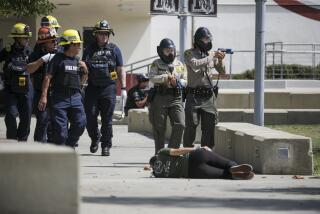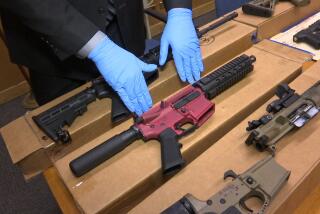Letting Teachers Pack Guns Will Make America’s Schools Safer
- Share via
Banning guns from schools seems the obvious way to keep children safe. Utah, though, is doing the opposite, and is stirring up debate across the nation.
Acting under a new state law, school districts across Utah have started drawing up regulations allowing teachers and other public employees to carry concealed guns on school property. Opponents are still trying to fight the law, and at first glance their concern about firearms in schools is understandable. Last Sunday in New Jersey, an attack by armed teenagers against three fellow students and randomly chosen townspeople was narrowly averted.
But that’s not the whole picture. Consider an analogy: Suppose a criminal is stalking you or your family. Would you feel safe putting a sign in front of your home saying, “This Home Is a Gun-Free Zone”? Law-abiding citizens might be pleased by such a sign, but to criminals it would be an invitation.
In 1985, just eight states had right-to-carry laws -- laws that automatically grant permits for concealed weapons once applicants pass a criminal background check, pay their fees and, when required, complete a training class. Today, 35 states do.
Examining all the multiple-victim public shootings in the United States from 1977 to 1999 shows that on average, states that adopt right-to-carry laws experience a 60% drop in the rates at which the attacks occur, and a 78% drop in the rates at which people are killed or injured from such attacks.
To the extent such attacks still occurred in right-to-carry states, they overwhelmingly take place in so-called “gun-free zones.” Indeed, the attack last week in Meridian, Miss., in which five people were killed took place in a Lockheed Martin plant where employees were forbidden to have guns.
The effect of right-to-carry laws is greater on multiple-victim public shootings than on other crimes for a simple reason: Increasing the probability that someone will be able to protect himself improves deterrence. Though it may be statistically unlikely that any single person in a crowd is carrying a concealed handgun, the probability that at least one person is armed is high.
Contrary to many people’s impressions, before the federal law was enacted in 1995 it was possible for teachers and other adults with concealed-handgun permits to carry guns on school property in many states.
Many of the concerns about accidents and other problems are unwarranted. The real problems at schools occurred only after the ban. The rash of student shootings at schools began in October 1997 in Pearl, Miss.
Public reaction against guns is understandable, given the horrific events shown on TV. But the more than 2 million times each year that Americans use guns defensively are never discussed. In more than 90% of those cases, simply brandishing a weapon is sufficient to cause a criminal to break off an attack. My research also shows that citizens with guns helped stop about a third of the post-1997 public school shootings, stepping in before uniformed police could arrive.
Last year, news broadcasts on the three main TV networks carried about 190,000 words on gun crime stories. Not one segment featured a civilian using a gun to stop a crime. Newspapers are not much better.
Police are extremely important in deterring crime, but they almost always arrive after the crime has been committed. Annual surveys of crime victims in the United States by the Justice Department show that when confronted by a criminal, people are safest if they have a gun.
Just as the threat of arrest and prison can deter criminals, so can the fact that victims can defend themselves.
For multiple-victim shootings, the biggest factor determining the amount of harm is the length of time between when an attack starts and when someone with a gun can stop the attack. The longer the delay, the more are harmed.
Good intentions do not necessarily make good laws. What counts is whether the laws ultimately save lives. Unfortunately, too many gun laws primarily disarm law-abiding citizens, not criminals.
More to Read
Sign up for Essential California
The most important California stories and recommendations in your inbox every morning.
You may occasionally receive promotional content from the Los Angeles Times.













